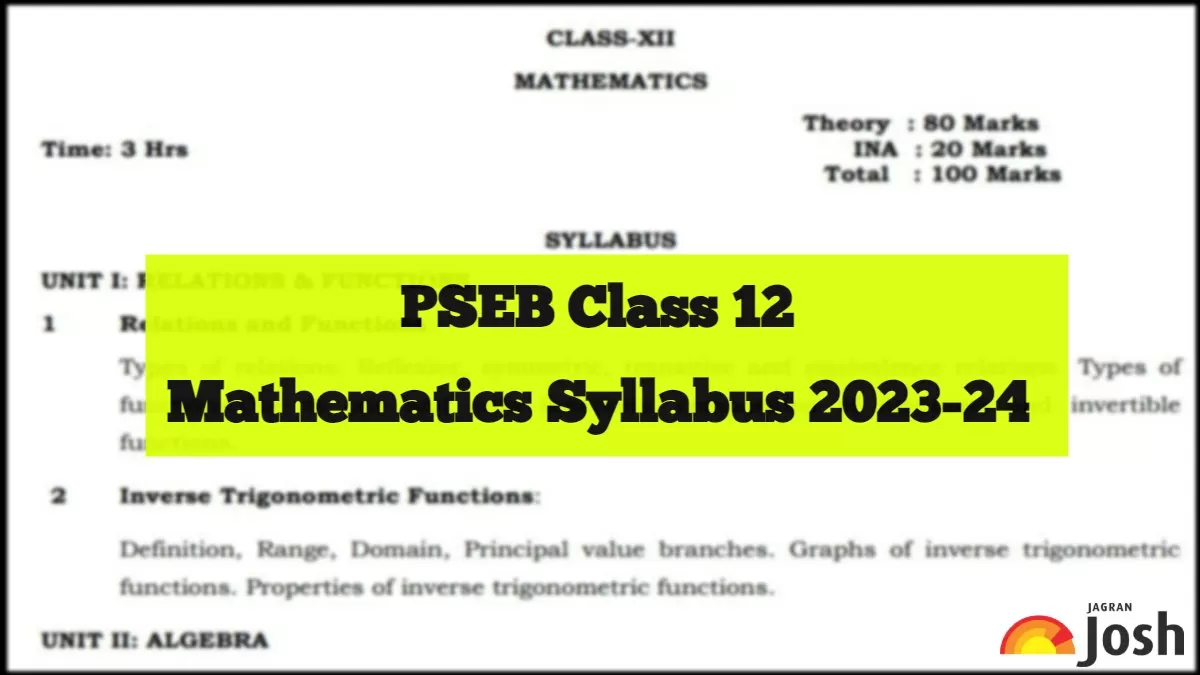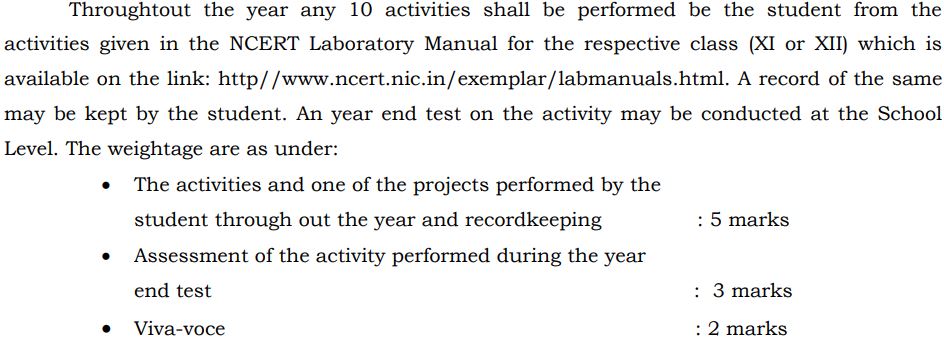Class 12 Maths Syllabus 2023-24 PSEB: Class 12 students of Punjab Board can get the Mathematics syllabus here for the 2023-24 academic session. The PSEB Class 12 Syllabus is a must have resource for students as they start study of a new subject in a new class. The new Mathematics syllabus includes important curriculum details like names of units, chapters and topics prescribed by bod for the class 12 students enrolled with PSEB. It also mentions the subject related activities and activities to help students learn practical applications and use the methodologies in real life problems. You can check and download the complete Punjab Board Class 12 Syllabus from the following section of this article.
PSEB Class 12 Maths Syllabus 2023-24
Course Structure:
| Theory Paper | 80 marks |
| Internal Assessment | 20 Marks |
| Total | 100 Marks |
The PSEB Class 12 Maths question paper in PSEB Board Exam 2024 will be for 80 marks. Students will be allowed to complete their paper within a time limit of 3 hours.
Also Check: PSEB Class 12 Syllabus 2023-24 All Subjects
Check unit-wise syllabus for PSEB Class 12 Maths below:
UNIT I: RELATIONS & FUNCTIONS
1 Relations and Functions:
Types of relations: Reflexive, symmetric, transitive and equivalence relations.
Types of functions: One to one and onto functions, composition of functions and invertible functions.
2 Inverse Trigonometric Functions:
Definition, Range, Domain, Principal value branches. Graphs of inverse trigonometric functions. Properties of inverse trigonometric functions.
UNIT II: ALGEBRA
3 Matrices:
Concept, notation, order, equality, types of matrices, zero and identity matrix, transpose of a matrix, symmetric and skew symmetric matrices.Operation of matrices. Addition and multiplication and multiplication with a scalar. Simple properties of addition, multiplication and scalar multiplication. Non-commutativity of multiplication of matrices and existence of non-zero matrices whose product is the zero matrix (restrict to square matrices of order 2). Invertible matrices and proof of the uniqueness of inverse, if it exists; (Here all matrices will have real entries).
4 Determinants:
Determinant of a square matrix (up to 3x3 matrices), minors, cofactors and applications of determinants in finding the area of a triangle. Adjoint and inverse of a square matrix. Consistency, inconsistency and number of solutions of system of linear equation by examples, solving system of linear equations in two or three variables (having unique solution) using inverse of a matrix.
UNIT III: Calculus
5 Continuity and Differentiability:
Continuity and Differentiability, derivative of composite functions, chain rule, derivative of inverse trigonometric functions, derivative of implicit function. Concepts of exponential and logarithmic functions.
Derivatives of logrithmic and exponential functions. Logarithmic differentiation,derivative of functions expressed in parametric forms. Second order derivatives.
6 Applications of Derivatives
Applications of derivatives: rate of change, increasing/decreasing functions, maxima and minima (first derivative test motivated geometrically and second derivative test given as a provable tool). Simple problems (that illustrate basic principles and understanding of the subject as well as real life situations).
7 Integrals:
Integration as inverse process of differentiation. Integration of a variety of functions by substitution, by partial fractions and by parts, Evaluation of simple integrals of the following types and problems based on them:
Fundamental Theorem of Calculus (without proof). Basic properties of definite integrals and evaluation of definite integrals.
8 Applications of the Integrals:
Applications in finding the area under simple curves, especially lines, circles/parabolas/ellipses (in standard form only).
9 Differential Equations:
Definition, order and degree, general and particular solutions of a differential equation. Solution of differential equations by method of separation of variables, solutions of homogeneous differential equations of first order and first degree. Solutions of linear differential equation of the type:
UNIT IV: VECTORS AND THREE DIMENSIONAL GEOMETRY
10 Vectors:
Vectors and scalars, magnitude and direction of a vector. Direction cosines and direction ratios of vectors. Types of vectors (equal, unit, zero, parallel and collinear vectors), position vector of a point, negative of a vector, components of a vector, addition of vectors, multiplication of a vector by a scalar, position vector of a point dividing a line segment in a given ratio. Definition, Geometrical interpretation, properties and application of scalar (dot) product of vectors, vector (cross) product of vectors.
11 Three-dimensional Geometry:
Direction cosines and direction ratios of a line joining two points. Cartesian equations and vector equation of a line, skew lines, shortest distance between two lines. Angle between two lines.
UNIT V: LINEAR PROGRAMMING
12 Linear Programming:
Introduction related terminology such as constraints, objectives function, optimization, Graphical method of solution for problems in two variables, feasible and infeasible regions (bounded or unbounded) feasible and infeasible solutions, optimal feasible solutions (up to three non-trivial constrains)
UNIT VI: PROBABILITY
13 Probability:
Conditional probability, multiplication theorem on probability, independent events; total probability, Baye's theorem.
INTERNAL ASSESSMENT - 20 Marks
| Mathematics Activities | 10 Marks |
| Distribution of marks under CCE(Besides Mathematics Activities ) | 10 Marks |
Note : For activities NCERT Lab Manual may be referred.
Conduct of Periodic Tests
1.Periodic Test is a Pen and Paper assessment which is to be conducted by the subject teacher.
2.In the entire Academic year, three periodic Tests in each subject may be conducted.
3.Once schools complete the conduct of all three periodic tests, they will convert the weightage of each of the three tests into ten marks each for identifying best two tests. The best two will be taken into consideration and the average of the two shall be taken as the final marks for PT.
4.The school will ensure simple documentation to keep a record of performance.
Assessment of Activity work:
ACTIVITIES
1. To verify that the relation R in the set L of all lines in a plane, defined by R = {(l,m):l⊥m} symmetric but neither reflxive nor transitive.
2. To verify that the relation R in the set L of all lines in a plane, defined by R = {(l,m):l||m} an equivalence relation.
3. To demonstrate a function which is not one-one but is onto.
4. To demonstrate a function which is one-one but not onto.
5. To draw the graph of sin-1x, using the graph of sin ݔ and demonstrate the concept of mirror reflection (about the line y = x).
6. To explore the principal value of the function sin-1x using a unit circle.
7. To sketch the graph of ax and logaxa > 0 a ≠ 1 and to examine that they are mirror images of each other.
8. To establish a relationship between common logarithm (to the base 10) and natural logarithm (to the base e ) of the number x.
9. To find analytically the limit of a function f(x) at x = c and also to check the continuity of the function at that point.
10. To verify that for a function f to be continuous at given point x0∆y =f(x0+∆x) - f(x0) is arbitrarily small provided ∆x is sufficiently small.
11. To understand the concept of decreasing and increasing functions.
12. To understand the concepts of local maxima, local minima and point of inflection.
13. To understand the concepts of absolute maximum and minimum values of a function in a given closed interval throuth its graph.
14. To construct an open box of maximum volume from a given rectangular sheet by cutting equal squares from each corner.
15. To find the time when the area of a rectangle of given dimension become maximum, if the length is decreasing and the breadth is increasing at given rates.
16. To verify that amongst all the rectangle of the same perimeter, the square has the maximum area.
17. To verify geometrically that vector c x (vector a + vector b) = vector c x vector a + vector c x vector b.
18. To verify that angle in a semi-circle is a right angle, using vector method.
19. To locate the points to given coordinates in space, measure the distance between two points in space and then to verify the distance using distance formula.
20. To measure the shortest distance between two skew lines and verify it analytically.
21. To explain the computation of conditional probability of a given event A, when event B has already occurred, through an example of throwing a pair of dice.
Projects
Project work in mathematics may be performed individually by a student or jointly by a group of students. These projects may be in the form of costruction such as curve sketching or drawing of graphs etc. It may offer a discussion of a topic from history of mathematics involving the historical development of particular subject in mathematics/ topics on concepts. Students may be allowed to select the topics of their own choice for projects in mathematics. The teacher may act as a facilitator by creating interest in various topics. Once the topic has been selected, the student should read as much about the topic as is available and finally prepare the project.
1. To minimise the cost of the food, meeting the dietary requirements of the staple food of the adolesent students of your school.
2. Estimation of the population of a particular region/country under the assumption that there is no migration in or out of the existing population in a particular year.
3. Finding the coordinates of different points identified in your classroom using the concepts of three dimensional geometry and also find the distance between the identified points.
4. Formation of differental equation to explain the process of cooling of boiled water to a given room temperature.
5. Project on histroy of Mathematicians: It may include history of Indian mathematicians such as Aryabhata, Brahmgupta, Varahamihir, Sridhara, Bhaskaracharya, Ramanujan etc. and history of foreign mathematicians such as Cantor, Pythagoras, Thales, Euclid,Appollonius, Descartes, Fermat, Leibnitz, Euler, Fibonac, Gauss, Newotn etc.
6. On linear Programming problems related to day-to-day life like collecting data from families of their expenditures and requirements from the factories to maximum output.
7. Collect data from dieticians, transporters, agents and formulate linear programming problems.
8. Make a chart of the formulae of applications of calculus.
9. Applications of conic sections, vectors, three dimansinonal geometry, calculus, etc., in Mathematics and Physics.
10. Mathematics and Chemistry: Study structure of organic compounds.
11. Mathematics and Biology: Study of science of heredity etc.
12. Mathematics and Music
13. Mathematics and Environment
14. Mathematics and Arts: Construction of shapes using curves
15. Mathematics and Information and Communication Technology: Writing of Mathematical Programmes, flow charts, algorithm, circuit diagrams etc.
16. Collection of statistical data and analysing it for standard deviation and mean deviation.
17. Observbe the various patterns and properties in Pascal's triangle and make a project.
18. Prepare a project based on the Fibonacci sequence, their properties and similar pattern found in nature.
19. Form a differential equation for the growth of bacteria in different environments.
20. Study the nature of mathematics and make a project showing where three aspects of nature of mathemetics- formalism, logic, intuition is applied in the development of mathematics.
Download the Class 12th Maths PSEB Syllabus in PDF from the following link:
| PSEB Class 7 Syllabus 2023-24 |
| PSEB Class 6 Syllabus 2023-24 |
Also Read: JEE Advance Admit Card



